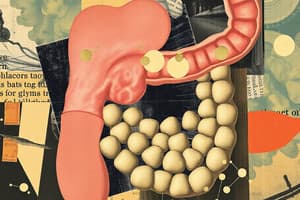Podcast
Questions and Answers
What is the primary role of villi and microvilli in the small intestine?
What is the primary role of villi and microvilli in the small intestine?
- To produce bile for fat digestion
- To transport food to the stomach
- To increase surface area for nutrient absorption (correct)
- To secrete digestive enzymes
How does the enteric nervous system contribute to gastrointestinal physiology?
How does the enteric nervous system contribute to gastrointestinal physiology?
- It absorbs nutrients from the small intestine
- It secretes hormones for digestion
- It initiates the mechanical breakdown of food
- It controls the movement of food through the GIT (correct)
Which of the following structures is primarily involved in the absorption of water and electrolytes?
Which of the following structures is primarily involved in the absorption of water and electrolytes?
- Large intestine (correct)
- Small intestine
- Stomach
- Esophagus
Which hormone is known for stimulating the secretion of gastric juices?
Which hormone is known for stimulating the secretion of gastric juices?
What is the name given to wave-like muscle contractions that help move food through the gastrointestinal tract?
What is the name given to wave-like muscle contractions that help move food through the gastrointestinal tract?
Which accessory organ is responsible for storing and concentrating bile?
Which accessory organ is responsible for storing and concentrating bile?
What condition is characterized by chronic inflammation of the gastrointestinal tract?
What condition is characterized by chronic inflammation of the gastrointestinal tract?
Which of the following is NOT a function of the gastrointestinal tract?
Which of the following is NOT a function of the gastrointestinal tract?
Flashcards are hidden until you start studying
Study Notes
Overview of Git Physiology
- Git physiology refers to the biological and functional aspects of the gastrointestinal tract (GIT).
- The GIT is responsible for digestion, absorption of nutrients, and excretion of waste.
Structure of the GIT
- Mouth
- Begins the digestive process with mechanical breakdown and saliva secretion.
- Esophagus
- A muscular tube that transports food to the stomach via peristalsis.
- Stomach
- Secretes gastric juices (acid and enzymes) for digestion.
- Mixes food into a semi-liquid form called chyme.
- Small Intestine
- Divided into duodenum, jejunum, and ileum.
- Primary site for digestion and absorption of nutrients.
- Contains villi and microvilli to increase surface area.
- Large Intestine
- Absorbs water and electrolytes, forming solid waste (feces).
- Includes the cecum, colon, rectum, and anus.
- Accessory Organs
- Liver: Produces bile, essential for fat digestion.
- Pancreas: Secretes digestive enzymes and bicarbonate.
- Gallbladder: Stores and concentrates bile.
Functions of the GIT
- Digestion: Breaking down food into smaller molecules.
- Absorption: Transporting nutrients into the bloodstream.
- Excretion: Eliminating indigestible substances and waste from the body.
Regulatory Mechanisms
- Nervous System: Controls the movement of food through the GIT (enteric nervous system).
- Hormonal Regulation: Hormones like gastrin, secretin, and cholecystokinin (CCK) regulate digestive processes.
Common Disorders
- Gastroesophageal Reflux Disease (GERD): Acid reflux causing heartburn.
- Irritable Bowel Syndrome (IBS): Affects bowel function and causes cramping and discomfort.
- Inflammatory Bowel Diseases (IBD): Includes Crohn's disease and ulcerative colitis, causing chronic inflammation of the GIT.
Key Concepts
- Peristalsis: Wave-like muscle contractions that move food through the GIT.
- Enzymatic Action: Enzymes break down macronutrients (carbohydrates, proteins, and fats) for absorption.
- Microbiome: The community of microorganisms in the GIT plays a crucial role in digestion and health.
Nutritional Considerations
- A balanced diet is essential for optimal GIT function.
- Fiber intake promotes gut health and regularity.
- Hydration is critical for digestion and nutrient absorption.
Overview of Git Physiology
- Git physiology encompasses the biological functions of the gastrointestinal tract (GIT), crucial for digestion, nutrient absorption, and waste excretion.
Structure of the GIT
- Mouth: Initiates digestion through mechanical breakdown and saliva production.
- Esophagus: Muscular tube facilitating food transport to the stomach through peristalsis.
- Stomach: Produces gastric juices (acid and enzymes) for breaking down food into chyme.
- Small Intestine: Comprises duodenum, jejunum, and ileum; primary site for nutrient digestion and absorption, enhanced by villi and microvilli.
- Large Intestine: Absorbs water and electrolytes, converting waste into feces; includes the cecum, colon, rectum, and anus.
- Accessory Organs:
- Liver: Generates bile for fat digestion.
- Pancreas: Produces digestive enzymes and bicarbonate to aid digestion.
- Gallbladder: Stores and concentrates bile from the liver.
Functions of the GIT
- Digestion: Involves the breakdown of food into smaller, absorbable molecules.
- Absorption: Nutrients are transported across intestinal walls into the bloodstream.
- Excretion: Removal of indigestible substances and waste from the body.
Regulatory Mechanisms
- Nervous System: Governed by the enteric nervous system, controlling GIT motility.
- Hormonal Regulation: Hormones such as gastrin, secretin, and cholecystokinin (CCK) modulate digestive processes.
Common Disorders
- Gastroesophageal Reflux Disease (GERD): Characterized by acid reflux leading to heartburn.
- Irritable Bowel Syndrome (IBS): Disruption in bowel function causing cramping and discomfort.
- Inflammatory Bowel Diseases (IBD): Includes Crohn's disease and ulcerative colitis, causing chronic GIT inflammation.
Key Concepts
- Peristalsis: Refers to wave-like muscle contractions moving food through the GIT.
- Enzymatic Action: Enzymes are vital for breaking down carbohydrates, proteins, and fats for effective absorption.
- Microbiome: The diverse microbial community in the GIT significantly influences digestion and overall health.
Nutritional Considerations
- Maintaining a balanced diet is crucial for optimal GIT operation.
- Sufficient fiber intake supports gut health and regular bowel movements.
- Adequate hydration is essential for effective digestion and nutrient uptake.
Studying That Suits You
Use AI to generate personalized quizzes and flashcards to suit your learning preferences.




